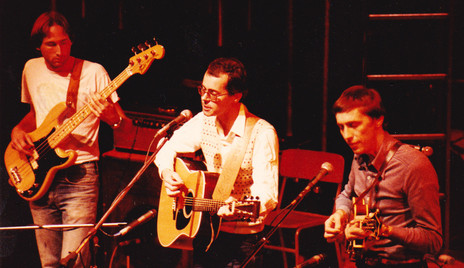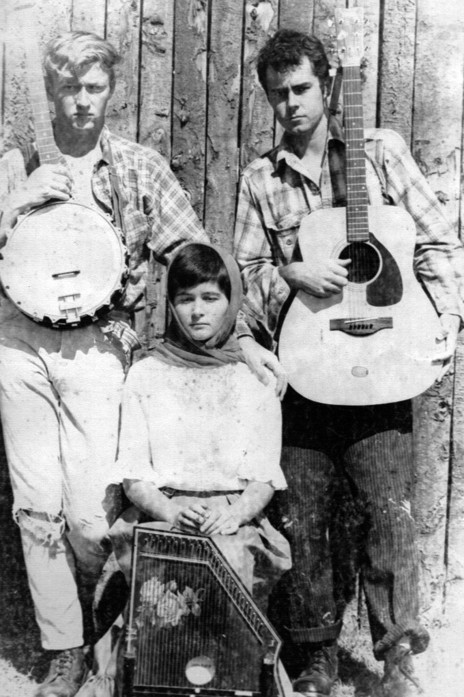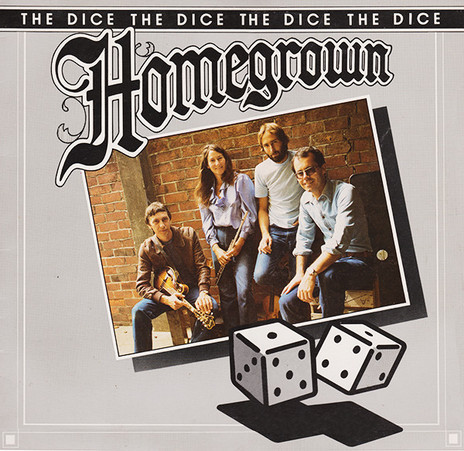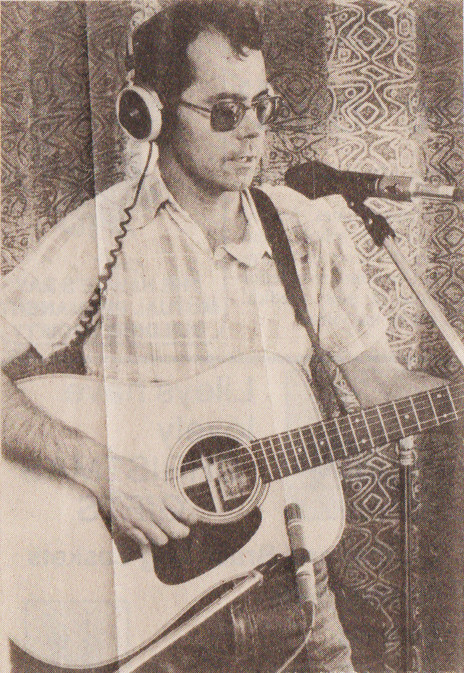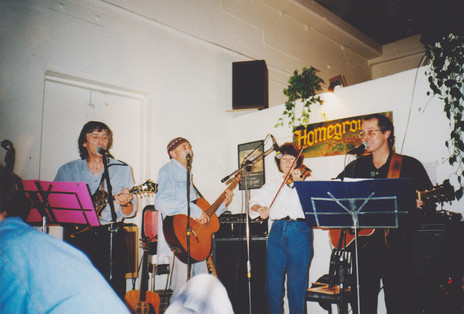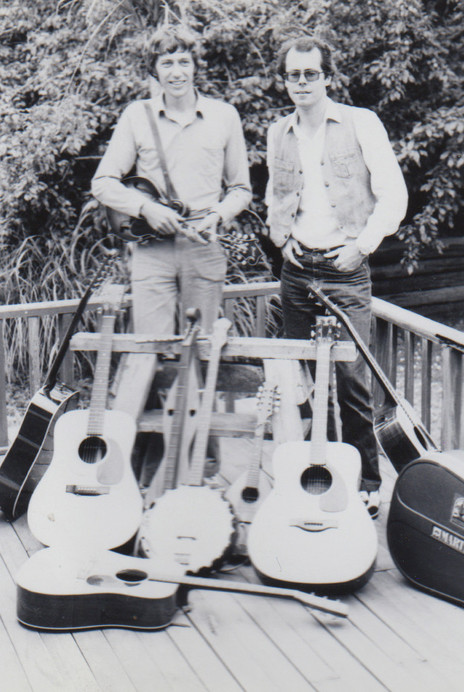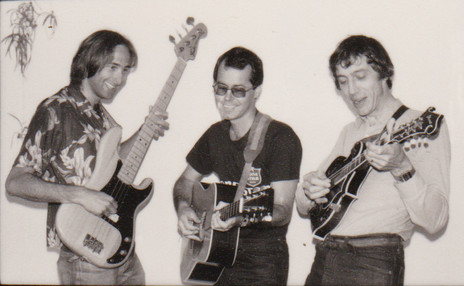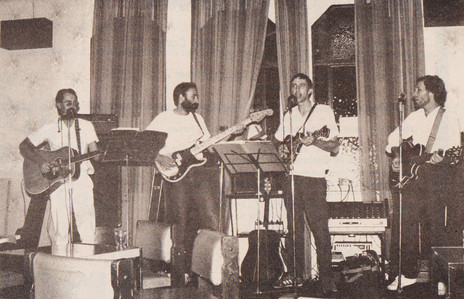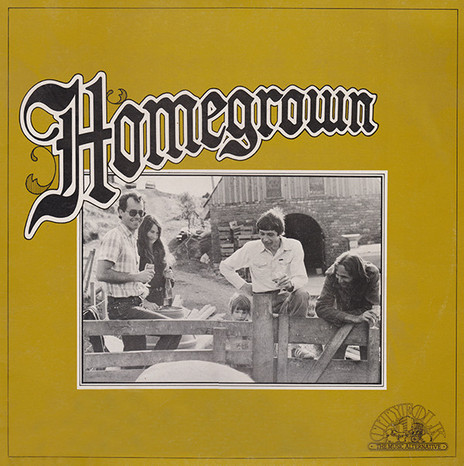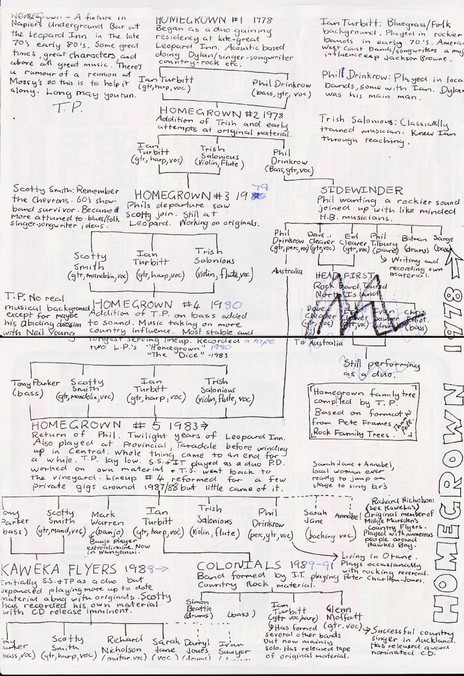Perched on stools on a small stage, the band would play on as a ragtag crowd listened, sang along, fought and grinned, often with their drinks pressed to their heads because they were squeezed so tight it was impossible to lift a glass from their side to their lips. The musicians became quite adept at repelling the heaving throng with their feet whenever a fight broke out.
The ex-bikie bar would come alive to the sound of Homegrown’s guitars, mandolin, flute and violin.
Decorated in the theme of the London Underground train system, the ex-bikie bar was downstairs from the Leopard Inn, which straddled Napier’s Marine Parade and Hastings Street, and would come alive to the sound of Homegrown’s guitars, mandolin, flute and violin while rock bands or duos came and went in the main bar above.
But the demise of the Underground Bar also brought about the end of the band as the barflies scattered and Homegrown struggled to find a new audience amid the changing musical landscape.
Singer-guitarist Ian Turbitt and banjo and mandolin player Harvey Whincop met at Ardmore Teachers’ Training College in South Auckland in the mid-1960s and began performing together in folk clubs such as Newmarket’s Poles Apart. They formed The Mountain Ramblers and appeared at the National Banjo Pickers’ Convention in Ngāruawāhia as well as on Kiwi Records’ convention highlights LPs from 1969 and 1970.
Their inclusion on the television show The Country Touch coincided with square dance caller Thelma Blyth insisting the dancers lowered the length of their skirts. So the dancers asked Turbitt, a caller himself, whether they would have to adjust their skirts if he was appointed square dance caller. He assured them they would not and so he was brought in as the new square dance caller for the final series. It even brought him some work with the show’s resident group The Hamilton County Bluegrass Band.
In the early 1970s, Turbitt went on his OE and started writing his own songs and performing them at folk clubs in England. Later he spent about a year on a kibbutz in Israel where fellow travellers who were writing their own songs introduced him to the material of new American artists such as Jackson Browne and the Eagles.
On his return to Napier he discovered the modern folk scene was not yet interested in local songwriters, so he teamed up again with Whincop and bass guitarist Phil Drinkrow in Flight and covered the so-called country rock emanating from the west coast of the United States.
Early on they secured the services of violin player and flautist Trish Salonius, who was a schoolteacher with Whincop’s wife at Wycliffe Intermediate. Throughout her childhood, Salonius studied violin and piano before spending a year at the University of Auckland doing an executant diploma in piano course. She taught herself flute and after a stint teaching, then working at Radio Taranaki, she travelled overseas, which included a musical specialty job teaching music in Vancouver.
Flight were resident at the Corner Bar of the Masonic Hotel in the city centre on Friday nights through most of 1974 to 1976 while Turbitt, Drinkrow and Trevor Ruffell, brother of Kiwi Records’ John Ruffell, ran the Napier Folk Club there every Wednesday night. The band broke up when Salonius and her husband decided to start a family. Turbitt established an open mic night at the Leopard Inn’s Underground Bar on Wednesdays before he and Drinkrow took up residency there as a duo on Thursdays and Fridays.
After her children were born, Salonius was cajoled back, and the trio eventually settled on the name Homegrown in honour of the Neil Young song of the same name. But Drinkrow was after something a bit rockier and left to join Sidewinder. Turbitt had been jamming with his Tamatea Primary School workmate Forbes “Scotty” Smith and invited him to come on board.
At rugby socials, weddings and twenty-firsts, rock’n’roll was snuck in amongst the veletas, maxinas and waltzes.
Smith had been in groups in Hawke’s Bay as a teen at the dawn of the 1960s playing at rugby socials, weddings and twenty-firsts. Their rock’n’roll and jive was snuck in amongst the veletas, maxinas and waltzes preferred by the ex-servicemen who were often paying them. He played every weekend in bands such as The Chevrons until the 1970s, but took a break when his children were small.
With Smith on mandolin, guitar and occasionally bass, the opportunity was there for a permanent bass player and a likely candidate was found in a recent arrival from Nelson, Tony Parker. He had become an Underground regular and Homegrown fan since taking up his first teaching post at Henry Hill School, where Ian Turbitt’s wife Jennie was also a teacher.
An avid fan of Bob Dylan, Neil Young, The Band, Gram Parsons and the west coast singer-songwriters, Parker could tell you who played a particular instrument on any particular album. He hung out with the band and eventually donned a guitar and sung a few Young favourites between their sets. Turbitt flippantly remarked if he learned to play bass he could become a permanent member, which he did initially on Smith’s old Diplomat instrument before investing in the Fender Precision he still plays today.
Their repertoire was what would now be labelled Americana: Guy Clark, Jerry Jeff Walker, Neil Young, Turbitt’s touchstone Jackson Browne. The carefree atmosphere of the Underground found Homegrown introducing Turbitt’s own songs, at first tentatively but then in a glut.
One weekend during December 1980, Homegrown went into Port Ahuriri School, where Turbitt was now a teacher, and recorded about 20 songs live to 2-track with folkie and bass guitarist Mitch Park engineering. The resulting cassette was more for band members and friends, but Homegrown were approached by Turbitt’s old Napier Folk Club ally Trevor Ruffell and his business partner Keith Gosney with the idea of putting it out as an LP on their new label Cityfolk Record Co. They pared the recording back to the best 12 songs and released it as Homegrown in 1981 – Cityfolk’s first release.
Apart from Smith’s ‘Lonely People’ and his instrumental ‘Full Flush’, the album was full of Turbitt’s songs touching on travel (‘Hanging Out In LA’, ‘Mexico City’) and Underground regulars (‘Cowboy At Heart’, ‘Underground Barfly’). Ironically, the band never took any of the records downstairs to sell.
Ruffell engaged members of the band as backing musicians for subsequent Cityfolk release Billy On The Boil by Graham Wilson and Turbitt backed Paul Bond and Kathryn Tait as well as contributing his own songs to the compilation record Paths. In lieu of session payments, Turbitt proposed Cityfolk finance a second Homegrown album.
The second LP, The Dice, was recorded on 4-track at the home studio of engineer John Holmes. Released in 1983, it featured Mark Warren on banjo and Phil Tilbury on keyboards. Scotty Smith sung his own ‘Arizona’, and Turbitt’s writing continued to mature with the beautiful ‘Katy’s Eyes’ and ‘A Friend Like Her’ and the Underground-inspired ‘Staggering Under The Weight of Saturday Night’ and ‘Bloodshot Eyes’.
On the rare occasions Homegrown escaped the Underground it was mostly for private functions. As far as gigging outside of Hawke’s Bay, they were restricted by the fact Salonius and her winemaker husband had a young family and she was unable to get away. The others made the odd trip to folk clubs – including Auckland, Tauranga and Wellington – and at one time Turbitt and Smith appeared with banjo player Mark Warren at John Grenell’s Whitecliffs Music Festival.
Around 1986 it became clear the management of the Leopard Inn was in trouble.
Warren joined the band for a year or so and Phil Drinkrow returned for a time, but around 1986 or so it became clear the management of the Leopard Inn was in trouble. The Underground was becoming rundown; smashed glasses from the night before were still in the corner as Homegrown kicked off anew and all of a sudden no-jeans dress codes were enforced without warning. The pub shut down not long after, later reopening as the Napier Cosmopolitan Club.
Homegrown moved to a residency in the back bar of the Provincial Hotel and began taking twenty-firsts and dance gigs. There were stints at the Taradale Hotel and the Central Hotel’s short-lived Dodge City Bar and Turbitt and Smith worked as a duo, but unable to find a listening audience to replace the Underground faithful, Homegrown slowly lost heart and called it a day.
All four remained active in the Hawke’s Bay music scene. Turbitt fronted several bands and released DIY cassettes under his own name and as part of The Colonials with Glen Moffatt, as well as recording with Scotty Smith and Phil Tilbury. Of late he has joined with journeyman bass guitarist Marty Forrer (ex-Chants R&B, Jumping Bones) in a number of line-ups.
Smith and Tony Parker are the core of Hawke’s Bay institution The Kawekas with one-time Midge Marsden’s Country Flyers bass guitarist Richard Nicholson. Formed a year or two after Homegrown’s demise, The Kawekas released their sole CD in the early 1990s and have been performing ever since. Trish Salonius continued with Chris and Alexandra Wilson in a jazz ensemble that overlapped with the last days of Homegrown, but she only plays occasionally now – mainly in one-off Homegrown reunions every couple of years.
